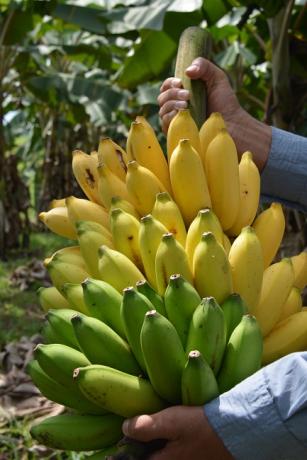Soil management influences fusariosis intensity in bananas
Soil management influences fusariosis intensity in bananas
A survey in banana production areas in São Paulo State, in Vale do Ribeira, Brazil's main banana producing region, has identified that soil factors can predispose banana plants to fusariosis. The study has shown that more acidic soils, with less availability of phosphorus, calcium or manganese and lower base saturation, cause plants to be more affected by the disease.
Production areas in the outskirts of the city of São Bento do Sapucaí were also assessed by researchers from Embrapa Environment, the Agronomic Institute of Campinas (IAC, from Portuguese), APTA (Agency for Agribusiness Technology)/Vale do Ribeira and Cati (Coordination of Integral Technical Assistance)/São Bento do Sapucaí. In that region, where banana plantations are managed using less chemical inputs (fertilizers and pesticides), the soil's physical attributes are more important to modulate the disease intensity.
"In banana cultivations in São Bento do Sapucaí,” explains Embrapa Environment technician Henrique Vieira, "more compact soils that are more resistant to root penetration determine a higher occurrence of fusariosis."
In all regions studied, in banana cultivars of the Pome subgroup, plants affected by the disease have presented nutritional imbalances, with lower calcium and potassium contents compared to nitrogen.
Even though the identification of this association between edaphic factors, plant nutritional status and the occurrence of fusariosis might seem at first a discovery of only theoretical interest, it is really important to farmers’ daily routines, as well as to those consumers who only want healthy and affordable fruit.
"Establishing recommendations for soil management practices that enable banana production in a scenario where the fusarium fungus is present depends on this basic knowledge," emphasizes Luiz Teixeira of the IAC.
For consumers, the immediate effect of a disease as serious as banana fusariosis is the reduction of fruit supply and the increase in price.
Observing that the plants’ health depends on the soil’s health has made researchers seek integrated solutions for disease control beyond the use of pesticides.
Following that project's results, the team has continued to study the relationship between biotic and abiotic factors, and the intensity of banana fusariosis both in field conditions and in greenhouses in a new project also funded by Fapesp (São Paulo State Research Foundation), which is scheduled to end in March 2022. In this project, they are also investigating alternatives for disease management oriented toward plant health through soil health, as well as to the reduction of predisposing factors, such as the presence of the banana root borer.
The team also intends to provide a multicriteria system of indicators for impact assessment and adoption of Good Management Practices directed at coping with banana fusariosis.
"We hope that, by the end of this second project, we can count on information that will allow us to design management strategies to cut down the losses caused by the disease and increase banana productivity," says Embrapa Environment researcher Jeanne Marinho Prado.
Banana – an important fruit for Brazil
Brazil is one of the world's largest banana producers, with around seven million tons of fruit being harvested annually.
Currently, banana fusariosis or Panama disease, which is caused by a soil fungus (Fusarium oxysporum f. sp. cubense)
is this crop's main disease. This disease was identified for the first time in Brazil, in 1939, affecting the Apple cultivar and it then spread quickly throughout the country, always causing considerable damage.
The production of Apple banana, for example, has become a "migratory" activity, requiring farmers to change areas each crop season in search of soils without the pathogen's presence. Another solution was planting cultivars that are less susceptible to the disease, such as Pome and bananas of the Dwarf type, which make up about 90% of crop areas.
However, the replacement of Apple banana by cultivars that are more resistant to fusariosis entails lower profitability for farmers since the prices of Pome and Dwarf bananas are always lower than those for Apple bananas.
Even though it is a currently widely used alternative, switching to fusariosis-resistant cultivars is an option that is being threatened by the spread of a new race of the fungus that causes the disease, known as Tropical Race 4 (TR4). TR4 has been destroying banana groves of all cultivars in Asia, Africa, and the Middle East, and in South America it has already been officially detected in Colombia and Peru.
Since the most common measures of disease control in plants, such as fungicide application or crop rotation, are inefficient in facing fusariosis, and there are no banana plant cultivars that are resistant to TR4, the aim is to identify possible soil conditions in which the plants are less affected by the disease.
It has been observed that bananas of the same cultivar can present different intensities of fusariosis, which suggests that environmental factors may be involved in this variation.
With Fapesp's support, researchers Luiz Teixeira (IAC), Daniel Heck (Federal University of Viçosa), Henrique Vieira and Miguel Dita (former researcher at Embrapa Cassava and Fruits) published the results of this research in the scientific journal Tropical Plant Pathology, in the article Soil attributes, plant nutrition and Fusarium wilt of banana in São Paulo, Brazil, available here.
Cristina Tordin (MTB 28499)
Embrapa Environment
Press inquiries
meio-ambiente.imprensa@embrapa.br
Phone number: +5519992626751
Translation: Raquel Porlan, supervised by Mariana Medeiros (13044/DF)
General Secretariat
Further information on the topic
Citizen Attention Service (SAC)
www.embrapa.br/contact-us/sac/


